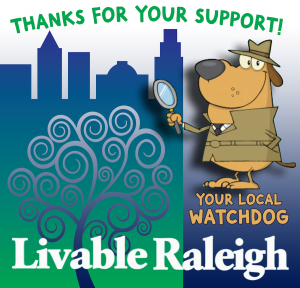
Michael Sutton describes himself as “just a citizen in east Raleigh.” He recently agreed to share the following comments on TODs (Transit Overlay Districts) that he sent to the Planning Commission for their 6/21 Text Change Committee meeting and 6/22 Committee of the Whole meeting.
I was inspired by a conversation with former City Council member Anne Franklin. She said “City Council needs Legos.” Since then I have carried to various meetings a representative model of my neighborhood. I live in the historically black neighborhood of Hungry Neck which is located in the New Bern-Edenton Neighborhood Conservation District and along the eastern corridor of the future BRT route.
One section of the model shows two representative houses from the neighborhood. There is a one-story bungalow that represents my neighbor, a house built by Rev. Clark in 1913. The neighborhood used to have many of such houses until urban renewal and the rezoning policies of the 1970s almost wiped out the neighborhood. This other house represents someone like me, a house built under the regulations of the NCOD. The neighborhood is full of old and modern homes coexisting through the neighborhood conservation overlay district. This was the City of Raleigh’s promise to preserve the character and scale of these historic neighborhoods that were almost lost.
Putting the Transit Overlay District on top of our historic neighborhoods is going back on that promise. One look at the two sections of my model put together showing the scale difference between a five-story apartment building ten feet away from a bungalow, and everyone who has seen it instantly knows it is wrong to allow that and that they would never want to live in that house. And that is how you erase a historic neighborhood one house at a time. Scale matters.
Official meetings regarding the TOD begin with a statement that this is a “City Initiated Rezoning Case.” I understand what that means, but please note that the City is its people, and we have not asked for this rezoning. What we asked for and voted for is better public transportation and the City Planners have been piggybacking controversial rezoning on the popularity of public transportation.
At every public and neighborhood meeting, among the many voices trying to protect our neighborhoods, there is always just one who speaks up in favor and they say that this rezoning is needed to support the BRT. Even our City Planners have publicly stated “The BRT and associated TOD rezoning projects are an investment in public transit in our region.” I could not disagree more with this idea.
The BRT can exist without destroying our neighborhoods because our City Council members have already admitted that the BRT is going to be connected to the transportation systems (and other BRTs) of nearby towns! This is no longer about local transit; it is about regional transit and therefore should be disconnected from local zoning. There is no need to erase my neighborhood with the TOD, if the BRT is transporting people from places like Clayton and Garner that is not required to have that same density! The implication that the BRT cannot succeed without the TOD is false.
Furthermore, I challenge you to find many more neighborhoods in Raleigh with single family housing that have a greater density. My property is only 40 feet wide. I did my homework – the property had been subdivided in 1920 and had not been built upon before my house in 2015. I joined this neighborhood knowing that I did not push out the families that were here before. Shortly after, without my knowledge, the City of Raleigh Planning Department put a picture of my house on their website, and it became the poster boy for their report on the benefits of infill housing downtown. Add that to the stories of my neighbors across the street on Mosely Lane where a city-initiated program led to a development of new houses and this neighborhood is a City success story in saving a historic neighborhood from previous urban renewal rezoning policies. It is a kick in the teeth now for us to be once again fighting for our neighborhood.
We recognize that there is a small carrot in the TOD regulations to encourage affordable housing. However, achieving neighborhood density through the removal of height restrictions only leads to apartments. There is a difference between affordable housing and affordable houses. Home ownership is the greatest asset to generational wealth. If you erase our neighborhood of homeowners and replace them with home renters, you will never be able to build enough affordable housing.
There are appropriate places for the TOD, but it is not within our historic neighborhoods and those that are supposed to be protected by a NCOD. The City Council has tried to appease us by changing the text that prohibits single family housing in the TOD, however, our neighborhood would have agreed that the prohibition would have been appropriate if you applied the TOD to commercial areas or parking lots.
We didn’t want you to change the text – change the map!
Vibrant cities all around the world have neighborhood pockets along their transit corridors and we can easily coexist with the BRT. However, if there is only a resolve to change the text, then we will continue to advocate for our neighborhood by insisting that the text of the TOD does not supersede the regulations of the NCOD. The City of Raleigh has a moral obligation to continue its promise to protect the character and scale of its protected historic neighborhoods.
If you appreciate the kind of reporting we bring to you
|
Please donate $10 or $20, Thanks for supporting |
 |

